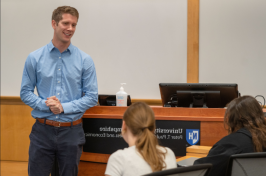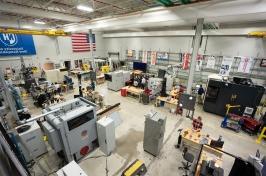
Three UNH researchers received prestigious grants that will connect them with the Department of Energy’s national laboratories to pursue research that aims to understand the early universe through ultralight dark matter, turn sunlight into energy-rich fuel, and help develop a groundbreaking national nuclear physics project.
Chanda Prescod-Weinstein, Gonghu Li, and Nathaly Santiesteban each received approximately $1 million and are among 39 national recipients of the DOE’s Established Program to Stimulate Competitive Research (EPSCoR). All three researchers emphasized the critical role of these laboratories in their research, establishing UNH as a leader in these areas and creating opportunities for UNH students.
Chanda Prescod-Weinstein: Unveiling Dark Matter Mysteries
  |
|
Chanda Prescod-Weinstein |
Prescod-Weinstein, an associate professor of physics, will use her award to further her groundbreaking research into ultralight dark matter. Her goal is to analyze how this type of dark matter might impact our observations of the early universe.
“One of the biggest open questions in physics is the nature of dark matter,” says Prescod-Weinstein. “It makes up 85% of the gravitating matter in the universe, yet we don’t know what kind of particle it is.”
Prescod-Weinstein’s work focuses on axions, a class of hypothetical particles, and how their existence might leave observable signatures in the light emitted in the universe’s earliest moments. This light, visible with today’s telescopes, could hold the key to understanding the fundamental forces that shaped galaxies. Through her partnership with staff scientists Risa Wechsler and Rebecca Leane from DOE’s SLAC National Accelerator Laboratory, Prescod-Weinstein and her team aim to refine the accuracy of predictions about dark matter's role in these cosmic events.
“Curiosity about the universe is fundamental to who we are as humans,” Prescod-Weinstein added. “It’s evident from books, films, and even the way science fiction shows like Star Trek which have shaped our technology goals, that dreaming of the bigger cosmic picture is part of how humans explore our humanity and fulfill our intellectual potential.”
Gonghu Li: Harnessing Solar Energy through Photocatalysis
  |
| Gonghu Li |
Li, a professor of chemistry, is focused on using sunlight to produce energy-rich fuel. His research in solar fuel production investigates new photocatalysts that convert carbon dioxide into fuel using water as a renewable source of electrons. This process, known as artificial photosynthesis, offers the potential to store solar energy in a form that could reduce reliance on fossil fuels.
“The planned ultrafast spectroscopic studies require access to the facilities and expertise that are only available at Argonne National Lab,” says Li. “This collaboration will enhance New Hampshire’s competitiveness in conducting solar energy research.”
Li’s work examines the role of heterojunctions, which are interfaces between two different materials, in improving the efficiency of these photocatalysts. His research could lead to more efficient ways to harness renewable energy and train the next generation of scientists in clean energy technologies.
Nathaly Santiesteban: Shaping the Future of Nuclear Physics
  |
| Nathaly Santiesteban |
Santiesteban, as assistant professor of physics, plans to contribute to the design and development of the Electron-Ion Collider (EIC), a groundbreaking nuclear physics project under construction at DOE’s Brookhaven National Laboratory. The EIC will explore how the smallest known particles, such as protons and neutrons, interact to form the universe’s visible matter. Santiesteban has played a pivotal role in the design of the ePIC detector, which will be the first deployed at the EIC.
Santiesteban ‘s work, which includes simulation studies and collaboration with leading researchers around the globe, is focused on the physics that the EIC will be able to uncover. By understanding how subatomic particles behave, the research has the potential to revolutionize our understanding of the fundamental building blocks of the universe.
“The EIC will push the boundaries of what’s possible in nuclear physics,” says Santiesteban, who work alongside UNH professors Karl Slifer and Elena Long, UNH alum and postdoc David Ruth, graduate student Olaiya Olokunboyo. “Our involvement will require that fundamental pieces of equipment for the EIC be commissioned at UNH, which highlights UNH’s role and importance in the next major accelerator project in the U.S.”




















































